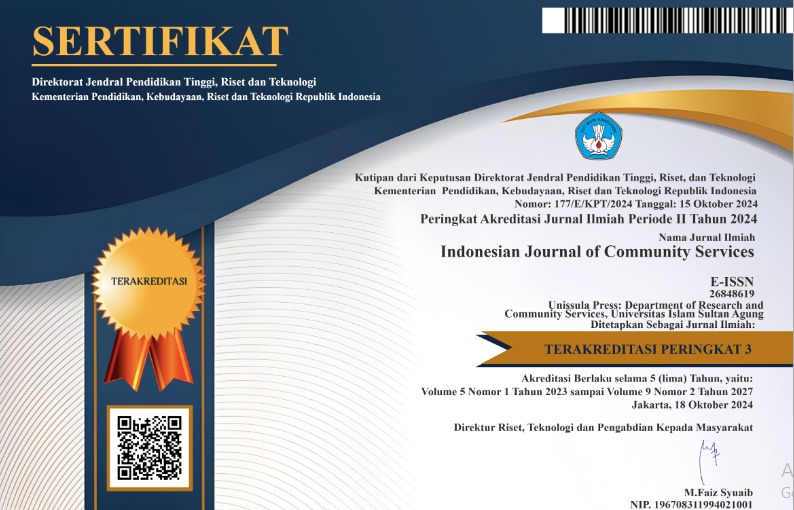Meningkatkan kemandirian pasien pasca stroke melalui in-house training kader pendukung lansia pasca stroke
Abstract
Abstrak
Insiden stroke mengenai populasi usia lanjut yang berusia 75-84 tahun sekitar 10 kali dari populasi 55-64 tahun. Berdasarkan Rencana Strategis Kementerian Kesehatan 2015-2019, maka perlu adanya upaya peningkatan promosi kesehatan dan pengabdian masyarakat, serta kegiatan promotif dan preventif, yang dapat dilakukan melalui peningkatkan peran aktif kader dalam upaya promotif dan preventif melalui praktik pendidikan kesehatan dengan tujuan untuk memandirikan klien dalam melakukan Activity Daily Living (ADL). Tujuan pengabdian masyarakat ini adalah menghasilkan kader yang terlatih melakukan pendidikan kesehatan dan praktik lapangan serta memberikan pencegahan pada lansia yang beresiko terhadap stroke di wilayah Puskesmas Buaran. Metode yang dilakukan dimulai dengan pembentukan kader pendukung lansia pasca stroke pada bulan September 2018, diikuti dengan pelatihan kader dan berakhir dengan monitoring dan evaluasi keterampilan kader secara mandiri di bulan Februari 2019. Hasil yang diperoleh yaitu terbentuknya 20 kader yang memiliki pengetahuan tentang konsep stroke dan cara melatih Activity Daily Living (ADL) sebelum dan setelah pelatihan (xˉ= 86) , praktik keterampilan (xˉ = 79.30), dan praktik lapangan (xˉ= 86,75). Kesimpulan dari pengabdian masyarakat ini adalah melalui pelatihan terstruktur dengan penyediaan keterampilan promosi kesehatan menejemen lansia pasca stroke akan mampu membentuk kader pendukung lansia pasca stroke yang terlatih.
Â
Kata kunci: Kader; lansia; stroke
Â
Abstract
Stroke incidence in the 75-84-year-old population is about 10 times that of the 55-64-year population. Based on the Ministry of Health's 2015-2019 Strategic Plan, it is necessary to improve health and community service promotion, as well as promotive and preventive activities, which can be done through increasing the active role of cadres in the field of health education and field practice on Activity Daily Living (ADL). The purpose of community service is to produce cadres who improve education and field practice and provide a budget for the elderly who are at risk of stroke in the Buaran health district. The method was begun with the formation of post-stroke supporting cadres in September 2018, followed by cadres training and ended by monitoring and evaluating cadre skills independently in February 2019. The results obtained were the formation of 20 cadres who were knowledgeable about the concept of stroke and methods training Activity Daily Living (ADL) before and after training (xˉ = 86), skill practice (xˉ = 79.30), and field practice (xˉ = 86.75). The conclusion of this community service is through structured training with the provision of health promotion skills for post-stroke elderly management will be able to form supporting cadres for trained post-stroke elderly.
Â
Keywords: Cadre; elderly; strokeKeywords
Full Text:
PDFReferences
Azizah, L. (2011). Keperawatan Lanjut Usia. Edisi Pertama. Yogyakarta: Graha Ilmu.
Basheti, I. A, Ayasrah, S. M, and Ahmad, M. (2018). Identifying treatment related problems and associated factors among hospitalized poststroke patients through medication management review: a multi-center study delivered in Jordan J Pharm Health Serv Res
Buffel, T. (2018). Social research and co-production with older people: Developing communities. Elseiver: Journal of Aging Studies 44: 52–60.
Daviet, J. C, Bonan, I, Caire, J. M, Colle, F, Damamme, Froger, L, Leblond, C, A. Leger, A, Muller, F, Simon, O, Thiebaut, M, and Yelnik, A. (2012). Therapeutic patient education for stroke survivors: Non-pharmacological management. A literature review. Elseiver Masson SAS. France
Dinas Kesehatan Kabupaten Pekalongan. (2015). Profil Kesehatan Kabupaten Pekalongan 2015. Pekalongan: Dinas Kesehatan Kabupaten Pekalongan.
Ehntholt, K. A., Yule, W. (2006). Practitioner review: assessment and treatment of refugee children and adolescents who have experienced war-related trauma. J Child Psychol Psychiatry 47: 1197-1210.
Erwanto, R., and Erjiyuane, T. A. (2017). Pembentukan Kader Lansia Peduli Stroke.
Indahsari, P. N, Agusman, F, and Ekowati, S. I. (2013). Hubungan Perubahan Fungsi Fisik Terhadap Kebutuhan Aktivitas Hidup Sehari-Hari (Ahs) Pada Lansia Dengan Stroke (Studi Pada Unit Rehabilitasi Sosial Kota Semarang). Jurnal Keperawatan Komunitas Vol 1 (1): 24-32.
Kemenkes RI. (2011). Pedoman Asuhan Keperawatan Keluarga di Rumah dengan Masalah Stroke (Pegangan Perawat). Jakarta
Lu, B, Zhang, R, and Chao, J. (2018). Health status and associated factors among the community-dwelling elderly women deliverd in China.
Nugroho, W. (2007). Keperawatan Gerontik. Edisi 2. Jakarta: EGC.
Praptiwi, A. (2008). Pemberdayaan Keluarga dalam Penatalaksanaan Lansia Pasca Stroke di Rumah.
Qupra, R, et al. (2009). Effectivenes of Supportive Educative Learning Programe on the Level of Strain Experienced by Caregivers of Stroke Patients in Thailand. Accessed March 2019, 13 http//www.cinahl.com.
Riskesdas. (2007). Profil Kesehatan Indonesia. Jakarta
Riset Kesehatan Dasar. (2013). Riset Kesehatan Dasar. Kementerian Kesehatan Republik Indonesia: Badan Penelitian dan Pengembangan Kesehatan.
UNFPA & Help Age International. (2012). Ageing in the twenty-first century : a celebration and a challenge. New York
World Health Organization. (2018). Adherence to long-term therapies: evidence for action. Sabaté E, ed. Geneva: World Health Organization.
Yaslina, Sahar, J, & Rekawati, E. (2012). Kelompok Pendukung Sebagai Intervensi Untuk Meningkatkan Kemampuan Keluarga Terhadap Perawatan Di Rumah Pada Aggregate Lansia Paska Stroke Di PGS, Depok.Karya Tulis Ilmiah.
DOI: https://dx.doi.org/10.30659/ijocs.1.1.95-104
Refbacks
- There are currently no refbacks.
Copyright (c) 2019 Indonesian Journal of Community Services

This work is licensed under a Creative Commons Attribution 4.0 International License.

